AEG-Electrolux SANTO 76308 KA User Manual
SANTO 76308 KA
User Manual |
Fridge |
Istruzioni d’uso |
Frigorifero |
Benutzerinformation |
Kühlschrank |

Dear Customer
Thank you for choosing one of our high-quality products.
With this appliance you will experience the perfect combination of functional design and cutting edge technology.
Convince yourself that our appliances are engineered to deliver the best performance and control - indeed we are setting the highest standards of excellence.
In addition to this you find environmental and energy saving aspects as an integral part of our products.
To ensure optimal and regular performance of your appliance please read this instruction manual carefully. It will enable you to navigate all processes perfectly and most efficiently.
To refer to this manual any time you need to, we recommend you to keep it in a safe place. And please pass it to any future owner of the appliance.
We wish you much joy with your new appliance.
The following symbols are used in this manual
Important information concerning your personal safety and information on how to avoid damaging the appliance
 General information and tips
General information and tips
 Environmental information
Environmental information
2

Contents |
|
Safety . . . . . . . . . . . . . . . . . . . . . . . . . . . . . . . . . . . . . . . . . . . . . . . . . . . . . |
.4 |
Disposal . . . . . . . . . . . . . . . . . . . . . . . . . . . . . . . . . . . . . . . . . . . . . . . . . . . . . |
6 |
Appliance Packaging Information . . . . . . . . . . . . . . . . . . . . . . . . . . . . . . . . . . |
6 |
Disposal of old Appliances . . . . . . . . . . . . . . . . . . . . . . . . . . . . . . . . . . . . . . . . . |
6 |
Remove transport packaging . . . . . . . . . . . . . . . . . . . . . . . . . . . . . . . . . . . . |
7 |
Installation . . . . . . . . . . . . . . . . . . . . . . . . . . . . . . . . . . . . . . . . . . . . . . . . . . |
7 |
Installation Location . . . . . . . . . . . . . . . . . . . . . . . . . . . . . . . . . . . . . . . . . . . . . |
7 |
Electrical connection . . . . . . . . . . . . . . . . . . . . . . . . . . . . . . . . . . . . . . . . . . . . . . |
8 |
Prior to Initial Start–Up . . . . . . . . . . . . . . . . . . . . . . . . . . . . . . . . . . . . . . .8 Control panel Fridge / Temperature setting buttons . . . . . . . . . . . . . . . . .9
Temperature display / Air Filter . . . . . . . . . . . . . . . . . . . . . . . . . . . . . . . . . . . . . .10
Installation of the charcoal filter . . . . . . . . . . . . . . . . . . . . . . . . . . . . . . . |
.11 |
|
Starting up and temperature regulation . . . . . . . . . . . . . . . . . . . . . . . . . . |
12 |
|
TURBO COOLMATIC . . . . . . . . . . . . . . . . . . . . . . . . . . . . . . . . . . . . . . . . . . . |
13 |
|
Switching off the appliance . . . . . . . . . . . . . . . . . . . . . . . . . . . . . . . . . . . . |
13 |
|
Interior Accessories . . . . . . . . . . . . . . . . . . . . . . . . . . . . . . . . . . . . . . . . . . |
14 |
|
Storage shelves . |
. . . . . . . . . . . . . . . . . . . . . . . . . . . . . . . . . . . . . . . . . . . . . . . . |
14 |
Variable Inner Door / Variable Storage Box . . . . . . . . . . . . . . . . . . . . . . . . . . |
15 |
|
LONGFRESH 0°C compartment . . . . . . . . . . . . . . . . . . . . . . . . . . . . . . . . . . |
15 |
|
Humidity control |
. . . . . . . . . . . . . . . . . . . . . . . . . . . . . . . . . . . . . . . . . . . . . . . . |
16 |
Drawers . . . . . . . . |
. . . . . . . . . . . . . . . . . . . . . . . . . . . . . . . . . . . . . . . . . . . . . . . . |
16 |
Correct Storage . . |
. . . . . . . . . . . . . . . . . . . . . . . . . . . . . . . . . . . . . . . . . . . . |
17 |
Defrosting . . . . . . |
. . . . . . . . . . . . . . . . . . . . . . . . . . . . . . . . . . . . . . . . . . . . |
20 |
Cleaning and Care |
. . . . . . . . . . . . . . . . . . . . . . . . . . . . . . . . . . . . . . . . . . . . |
20 |
Energy Saving Tips . . . . . . . . . . . . . . . . . . . . . . . . . . . . . . . . . . . . . . . . . . . |
21 |
|
What to do if ... |
. . . . . . . . . . . . . . . . . . . . . . . . . . . . . . . . . . . . . . . . . . . . .21 |
|
Correcting Malfunctions . . . . . . . . . . . . . . . . . . . . . . . . . . . . . . . . . . . . . . . . . |
21 |
|
Changing the light bulb . . . . . . . . . . . . . . . . . . . . . . . . . . . . . . . . . . . . . . . . . |
24 |
|
Customer Service |
. . . . . . . . . . . . . . . . . . . . . . . . . . . . . . . . . . . . . . . . . . . . |
24 |
Noises during Operation . . . . . . . . . . . . . . . . . . . . . . . . . . . . . . . . . . . . . . . . . . . |
25 |
|
Regulations, Standards, Guidelines . . . . . . . . . . . . . . . . . . . . . . . . . . . . . . . . . . |
25 |
|
Technical terminology . . . . . . . . . . . . . . . . . . . . . . . . . . . . . . . . . . . . . . . . . . . . |
26 |
|
3

 Safety
Safety
The safety aspects of our refrigerators comply with accepted technical standards and the German Appliance Safety Law. Nevertheless, we consider it our obligation to make you aware of the following safety information:
Intended use
•The refrigerator is intended for use in the home. It is suitable for the storing of food at low temperature. If the appliance is used for purposes other than those intended or used incorrectly, no liability can be accepted by the manufacturer for any damage that may be caused.
•Alterations or changes to the refrigerator are not permitted for reasons of safety.
•If you use the refrigerator in a commercial application or for purposes other than the cooling of foods, the manufacturer accepts no liability for any damages which may occur.
Prior to initial start–up
•Check the appliance for transport damage. Under no circumstance should a damaged appliance be plugged in. In the event of damage, please contact your supplier.
•Ensure that the appliance does not stand on the electrical supply cable. Important: If the supply cord is damaged, it must be replaced by the manufacturer, its service agent or similarly qualified persons in order to avoid a hazard.
Refrigerant
The refrigerant isobutane (R600a) is contained within the refrigerant circuit of the appliance, a natural gas with a high level of environmental compatibility, which is nevertheless flammable.
•Warning - During transportation and installation of the appliance, be certain that none of the components of the refrigerant circuit become damaged.
•If the refrigerant circuit should become damaged:
–avoid open flames and sources of ignition;
–thoroughly ventilate the room in which the appliance is situated.
Safety of children
•Packaging (e.g. wraps, polystyrene) can be dangerous for children. There is a risk of suffocation! Keep packaging material away from children!
4

Safety
•Please make old appliances unusable prior to disposal. Pull out the mains plug, cut off the mains cable, break or remove spring or bolt catches, if fitted. By doing this you ensure that children cannot lock themselves in the appliance when playing (there is risk of suffocation!) or get themselves into other dangerous situations.
•This appliance is not intended for use by persons (including children) with reduced physical, sensory or mental capabilities, or lack of experience and knowledge, unless they have been given supervision or instruction concerning use of the appliance by a person responsible for their safety. Children should be supervised to ensure that they do not play with the appliance. !
Daily Operation
•Containers with flammable gases or liquids can leak at low temperatures. There is a risk of an explosion! Do not store any containers with flammable materials such as spray cans, fire extinguisher refill cartridges etc in the refrigerator and/or freezer.
•Warning - Do not operate any electrical appliances in the refrigerator and/or freezer (e.g. electric ice cream makers, mixers etc.).
•Warning - In order not to impair the function of the appliance, never cover or obstruct the ventilation openings.
•Warning - Do not damage the cooling circuit.
•Before cleaning the appliance, always switch off the appliance and unplug it, or pull the house fuse or switch off the circuit breaker.
•When unplugging always pull the plug from the mains socket, do not pull on the cable.
In case of malfunction
•If a malfunction occurs on the appliance, please look first in the "What to do if ..." section of these instructions. If the information given there does not help, please do not perform any further repairs yourself.
•Refrigerators/freezers may only be repaired by qualified service engineers. Improper repairs can give rise to significant hazards. If your appliance needs repairing, please contact your specialist dealer or our Customer Service.
5
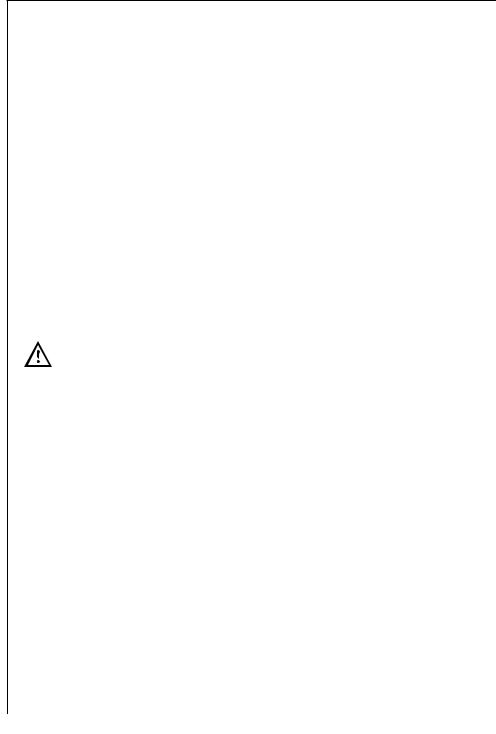
Disposal
Appliance Packaging Information
All materials are environmentally sound! They can be disposed of or burned at an incinerating plant without danger.
About the materials: The plastics can be recycled and are identified as follows:
>PE< for polyethylene, e.g. the outer covering and the bags in the interior.
>PS< for polystyrene foam, e.g. the pads, which are all free of chlorofluorocarbon.
The carton parts are made from recycled paper and should be disposed of at a waste-paper recycling collection location.
Disposal of old Appliances
For environmental reasons, refrigeration appliances must be disposed of properly. This applies to your old appliance, and - at the end of its service life - for your new appliance as well.
Warning! Before disposing of old appliances make them inoperable. Remove plug from mains, sever the power cable, remove or destroy any snap or latch closures. This ensures that playing children do not lock themselves inside the appliance (danger of suffocation!) or place themselves into other life-endangering situations.
Disposal:
•The appliance may not be disposed of with domestic waste or bulky refuse.
•The refrigerant circuit, especially the heat exchanger at the back of the appliance, must not be damaged.
•The symbol  on the product or on its packaging indicates that this product may not be treated as household waste. Instead it shall be handed over to the applicable collection point for the recycling of electrical and electronic equipment. By ensuring this product is disposed of correctly, you will help prevent potential negative consequences for the environment and human health, which could otherwise be caused by inappropriate waste handling of this product. For more detailed information about recycling of this product, please contact your local city office, your household waste disposal service or the shop where you purchased the product.
on the product or on its packaging indicates that this product may not be treated as household waste. Instead it shall be handed over to the applicable collection point for the recycling of electrical and electronic equipment. By ensuring this product is disposed of correctly, you will help prevent potential negative consequences for the environment and human health, which could otherwise be caused by inappropriate waste handling of this product. For more detailed information about recycling of this product, please contact your local city office, your household waste disposal service or the shop where you purchased the product.
6

Remove transport packaging
The appliance and the interior fittings are protected for transport.
1. Pull off the adhesive tape on the left and right side of the door.
2.Remove all adhesive tape and packing pieces from the interior of the appliance.
Installation
Installation Location
The appliance should be set up in a well ventilated, dry room.
Energy use is affected by the ambient temperature. The appliance should therefore
–not be exposed to direct sunlight;
–not be installed next to radiators, cookers or other sources of heat;
–only be installed at a location whose ambient temperature corresponds to the climate classification, for which the appliance is designed.
The climate classification can be found on the serial plate, which is located at the left on the inside of the appliance.
The following table shows which ambient temperature is correct for each climate classification: each climate classification:
Climate classification |
|
for an ambient temperature of |
|
|
|
|
|
|
SN |
|
+10 bis +32 °C |
|
|
|
N |
|
+16 bis +32 °C |
|
|
|
ST |
|
+16 bis +38 °C |
|
|
|
T |
|
+16 bis +43 °C |
|
|
|
If installation next to a source of heat is unavoidable, the following minimum clearances must be maintained at the sides of the appliance:
–for electric cookers 3 cm;
–for oil and coal fired ranges 30 cm.
If these clearances cannot be maintained a heat insulating pad is required between the cooker and the refrigeration appliance.
7

Electrical connection
Before initial start-up, refer to the appliance rating plate to ascertain if supply voltage and current values correspond with those of the mains at the installation location.
e.g.: |
AC |
220 ... |
240 V |
50 Hz or |
|
220 ... |
240 V~ |
50 Hz |
|
(i.e. 220 to 240 volts alternating current, 50 Hertz) The rating plate is inside the appliance on the left.
A correctly installed, earthed socket is required for the electrical supply. The supply must have a fuse rating of at least 10 Amps.
If the socket is not accessible once the appliance is built in, the electrical installation must include suitable means of isolating the appliance from the mains (e.g. fuse, cut-out, current trip or similar with a minimum contact separation of 3 mm).
Attention: The mains connection cable may only be replaced by a skilled electrician. Please contact your dealer or our customer service department for repairs.
Prior to Initial Start–Up
Please clean the appliance interior and all accessories prior to initial start-up (see section: “Cleaning and Care”).
Standby time
The oil for automatic lubrication contained in the compressor may flow into the refrigeration circuit if the appliance is transported in an inclined position. To allow the oil to flow back into the compressor, wait approximately 2 hours before placing the appliance in operation.
8

Description of the appliance
Control panel Fridge
1Pilot light (green)
2ON/OFF switch
3Temperature setting buttons (for warmer temperatures)
4Temperature display
5Temperature setting buttons (for colder temperatures)
6TURBO COOLMATIC indicator light (yellow)
• TURBO COOLMATIC for intensive fridge cooling
7Push button for TURBO COOLMATIC
Temperature setting buttons
The temperature is adjusted using the „+“ (WARMER) and „-“ (COLDER) buttons.
These buttons are connected to the temperature display.
•The temperature display is switched over from the display of the ACTUAL temperature (temperature display is illuminated) to the display of the DESIRED temperature (temperature display flashes) by pressing one of the two buttons, „+“ or „-“.
•With each further press of one of the two buttons, the DESIRED temperature is adjusted by 1°C.
•If neither button is pressed, the temperature display automatically switches back after a short period (approx. 5 sec.) to the display of the ACTUAL temperature.
DESIRED temperature means:
The temperature that is required in the refrigerator, this can be adjusted to the temperatures shown in the display. The DESIRED temperature is indicated by flashing numbers.
9
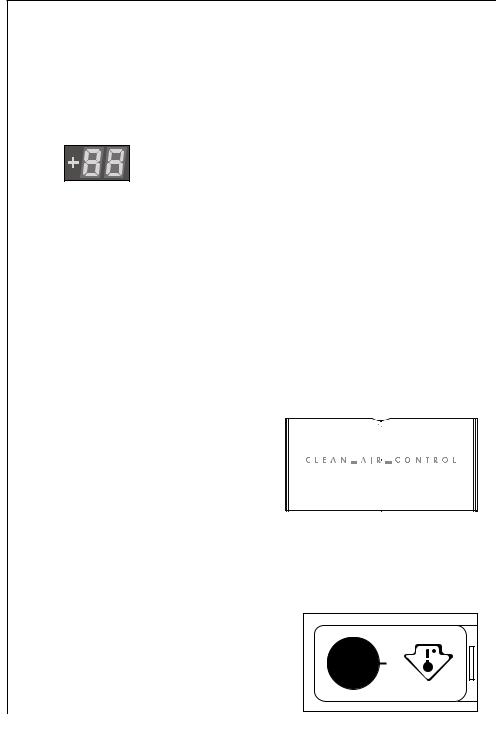
Description of the appliance
ACTUAL temperature means:
The temperature display indicates the temperature that is currently present in the refrigerator. The ACTUAL temperature is indicated by continuously illuminated numbers.
Temperature Display
The temperature display can indicate several pieces of information.
•During normal operation, the temperature currently present in the refrigerator (ACTUAL temperature) is displayed.
•When the temperature is being adjusted, the temperature currently set flashes (DESIRED temperature).
•If the electronics in the appliance have detected a fault that prevents the ACTUAL temperature being measured, the temperature display shows a square. The appliance will continue to function using a backup programme until your local Customer Service engineer has repaired the appliance.
Air Filter
Your appliance is equipped with a charcoal filter “CLEAN AIR CONTROL” in the rear wall of the fridge
compartment. The filter purifies the air from
unwanted odours in the fridge and LONGFRESH compartment meaning
that the storage quality will be further improved.
Note: Always keep the air ventilation flap closed.
The charcoal filter is a consumable accessory and as such is not covered by the guarantee.
Warning: this appliance is sold in France.
In accordance with regulations valid in this country it must be provided with a special device (see figure)
placed in the lower compartment of the fridge., to indicate the cold-
est zone.
10

Description of the appliance
Installation of the charcoal filter
On delivery the charcoal filter is placed in a plastic bag to secure the length of life of the charcoal filter. The filter should be placed behind the flap before the appliance is turned on.
1. Pull the cover outward (1). |
1 |
2. |
The charcoal filter is then mounted in the |
2 |
|
||
|
slot found in the back of the cover (2). |
|
3. |
Close the flap. |
|
|
Important! |
|
During operation, always keep the air ventilation flap closed.
The filter should be handled carefully so fragments do not loosen from the surface.
Changing the charcoal filter
To maintain the best performance the carbon filter should be changed every year.
|
New charcoal filters can be purchased |
1 |
|
from your local dealer. |
|
1. |
The filter is placed behind the cover and |
|
|
can be reached by pulling the cover out- |
|
|
ward (1). |
|
2. |
The charcoal filter is then pulled out of its |
2 |
|
slot. |
|
3. |
The new charcoal filter is placed in the |
|
|
existing slot (2). Close the flap. |
|
11

Starting up and temperature regulation
1. Insert the plug into the plug socket. When the refrigerator compartment door is opened, the internal lighting is switched on.
2.Press ON/OFF button.
The green mains pilot indicator and the temperature display illuminate.
3.Press either the „+“ (WARMER) or „-“ (COLDER) button.
The temperature display switches over and the DESIRED temperature currently set flashes on the temperature display.
4.Set the required temperature by pressing the „+“ (WARMER) or „-“ (COLDER) buttons (see section "Temperature setting buttons"). The temperature display will immediately show the changed setting. With each further press of one of the two buttons, the DESIRED temperature is adjusted by 1°C.
Adjustable temperature range: +3°C to +8°C.
Note: From a food safety point of view, +5°C for the refrigerator compartment should be considered cold enough as a storage temperature.
5.Once the required temperature has been set, after a short period (approx. 5 sec.) the temperature display will change and again indicate the current ACTUAL temperature inside the fridge. The display will change from flashing to continuous illumination.
The compressor will start and then run automatically.
Information! When the setting is changed, the compressor does not start immediately if automatic defrosting is currently taking place.
Goods to be refrigerated can be loaded immediately after switching on, because the storage temperature in the refrigerator is quickly reached.
In the LONGFRESH 0°C compartment the temperature is controlled automatically. It stays constantly at about 0°C, no adjustment is necessary.
Note: The refrigerator compartment is fitted with a fan. This quickly cools food stuffs and ensures optimal distribution of the temperature between the fridge and the LONGFRESH 0°C compartment.
This results in the fan operating at different speeds for different lengths of time. This is quite normal and not a fault with the appliance.
12

TURBO COOLMATIC
TURBO COOLMATIC Button
The TURBO COOLMATIC function is suited for quick cooling of large quantities of goods in the refrigerator, e.g. drinks and salads for a party.
1. The TURBO COOLMATIC function is switched on by pressing the TURBO COOLMATIC button. The yellow light illuminates.
2.The TURBO COOLMATIC function now ensures intensive cooling. A DESIRED temperature of +3°C is automatically selected. The TURBO COOLMATIC function is ended automatically after a period of 6 hours. The originally selected DESIRED temperature is again valid and the compartment will return to. The temperature display shows the ACTUAL refrigerator temperature.
3.The TURBO COOLMATIC function can be ended manually at any time by pressing the TURBO COOLMATIC button again. The yellow light goes out.
Switching off the appliance
To switch off, press the ON/OFF button for approx. 5 seconds. This will result in a countdown from "3" to "1" taking place in the temperature display. On reaching "1" the fridge will switch off. The temperature display will go off.
Note: The appliance cannot be switched on or off if unplugged, or if there is no power being supplied to it. Following connection to the mains power supply, the appliance returns to the same operating state as before the interruption of main power.
If the appliance is not going to be used for an extended period:
1. Remove all refrigerated packages.
2.Switch off the appliance by holding down the ON/OFF button until the display goes off (see above).
3.Remove the mains plug or switch off or disconnect from the electricity supply.
4.Clean thoroughly (see section “Cleaning and Care”).
5.Leave the doors open to avoid the build up of odours.
13
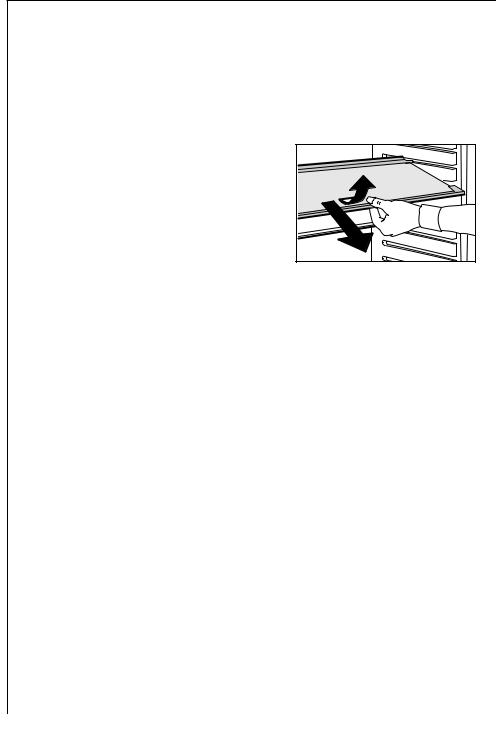
Interior Accessories
Storage shelves
On the bottom of the refrigerator compartment, just above the LONGFRESH 0°C compartment, you can easy place can and bottles in horizontal position. The structure of
this area will prevent the bottles and cans from moving around.
The height of the storage shelves can be adjusted:
1. To do this pull the storage shelf forward until it can be swivelled upwards or downwards and removed.
2. Please do the same in reverse to insert the shelf at a different height.
Your appliance is equipped with two half-size glass storage shelves. Storing tall items:
Slide the front half of the Vario storage shelf in another level to the rear. By this means you will gain space to place tall items on the storage shelf below.
14

Variable Inner Door
The door compartments can be pulled up and removed, and inserted at other positions as needed.
Variable Storage Box
Some models are equipped with a variable storage box which is fitted under a door shelf compartment and can be slid sideways.
The box can be inserted under any door shelf compartment.
1. To change the position of the storage box; lift the shelf compartment with the box upwards and out of the holders in the door and remove the retaining bracket out of the guide under the shelf compartment.
2.Reverse the above operation to insert
the shelf at a different height.
LONGFRESH 0°C compartment
In the LONGFRESH 0°C compartment the temperature is controlled automatically. It stays constantly at about 0°C, no adjustment is necessary.
The constant storage temperature of about 0°C and the relative humidity of between 45 and 90 % provide optimal conditions for the various kinds of food.
You can therefore store a variety of fresh food in the LONGFRESH 0°C compartment, where it will last up to 3 times longer with better quality compared to normal refrigerator compartments.
This allows you to stock more fresh food. Taste, degree of freshness, quality and nutritional values (vitamins and minerals) are well preserved. Loss of weight in vegetables and fruit diminishes. Food yields a higher degree of nutritional value.
The LONGFRESH 0°C compartment is also suitable for defrosting food. In this case the thawed food can be stored up to two days in the LONGFRESH 0°C compartment.
15
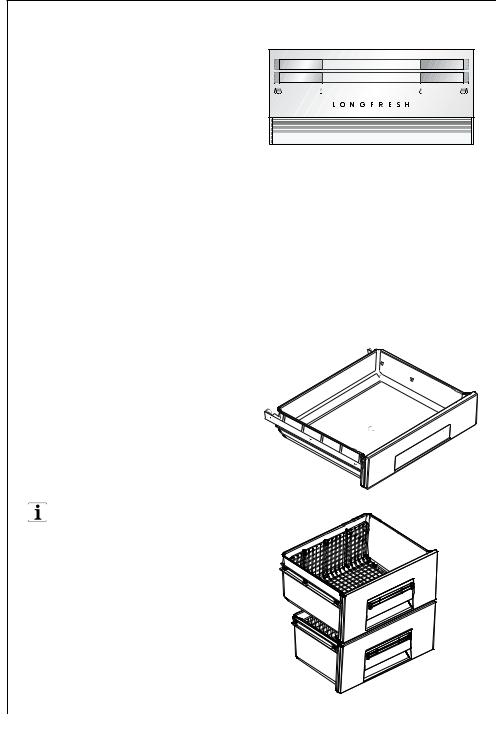
LONGFRESH 0°C compartment
Humidity control
Both bottom drawers can be used according to the desired storage conditions independently of each other with lower or higher humidity.
Regulation for each drawer is sep-  arate and is controlled using the slide valve at the front of the drawer.
arate and is controlled using the slide valve at the front of the drawer.
• „Dry“: low air humidity - up to 50 % relative humidity
This humidity level is reached when both sliders are set into this position  and the ventilation openings are wide open.
and the ventilation openings are wide open.
•„Humid“: high relative humidity - up to 90%
This humidity level is reached when both sliders are set in this posi-
tion  and the ventilation openings are closed. Humidity is kept and can not escape.
and the ventilation openings are closed. Humidity is kept and can not escape.
Drawers
In this drawer the humidity is not adjustable
The wire shelves inside the drawers permit that air can circulate freely and consequently a better conservation of foods.
The compartment has stops to prevent the drawers from falling out when fully extended.
To remove the drawers (e.g. for cleaning purposes), pull them out as far as the stops, lift and extract.
16

Correct storage
The refrigerator compartment is fitted with a fan. This quickly cools food stuffs and ensures optimal distribution of the temperature between the fridge and the LONGFRESH 0°C compartment.
The following can be conserved in the refrigeration compartment:
-beverages, preserves, jars, bottles;
-baked goods, prepared foods;
-products with short-term expiration;
-foods which are not suitable for conservation at the temperature of the LONGFRESH 0°C compartment.
Tips:
•Do not place warm foods or uncovered liquids in the refrigerator.
•Place foods in such a way that air can circulate freely.
•Keep butter and cheese in the special compartment to guarantee their consistency and aroma.
•Foods, and especially salad, must be kept well covered or packaged in such a way that they do not dry out and that their flavours and fragrances remain unchanged.
The following are suited for packaging:
–Polyethylene airtight bags and wraps;
–Plastic containers with lids;
–Special plastic covers with elastic;
–aluminium foil.
•High-proof spirits should only be conserved tightly closed and in a vertical position.
•Do not keep explosive or flammable materials in the refrigerator.
Conserve in the LONGFRESH 0°C compartment all foods which are suited to it.
Storage time in the LONGFRESH 0°C compartment for fresh food
Type of food |
|
Air humidity adjustment |
|
Storage time |
|
|
|
|
|
|
|
|
|
|
Onion |
|
“dry” |
|
up to 5 months |
|
|
|
|
|
|
|
|
|
|
|
|
|
|
|
Butter |
|
“dry” |
|
up to 1 month |
|
|
|
|
|
|
|
|
|
|
|
|
|
|
|
Large pork cuts |
|
“dry” |
|
up to 10 days |
|
|
|
|
|
|
|
|
|
|
17

Correct Storage
Type of food |
|
Air humidity adjustment |
|
Storage time |
|
|
|
|
|
Beef, venison, small pork |
|
“dry” |
cuts, poultry |
|
|
|
|
|
|
|
|
Tomato sauce |
|
“dry” |
|
|
|
|
|
|
|
|
|
Fish, shellfish, cooked meat |
|
“dry” |
products |
|
|
|
|
|
|
|
|
Cooked seafood |
|
“dry” |
|
|
|
|
|
|
|
|
|
Salad, vegetables |
|
|
Carrots, herbs, Brussels |
|
“humid” |
sprouts, celery |
|
|
|
|
|
|
|
|
|
|
|
Artichokes, cauliflower, |
|
|
chicory, iceberg lettuce, |
|
“humid” |
endive, lamb’s lettuce, let- |
|
|
tuce, leeks, radicchio |
|
|
|
|
|
|
|
|
Broccoli, Chinese leaves, |
|
|
kale, cabbage, radishes, |
|
“humid” |
Savoy cabbage |
|
|
|
|
|
|
|
|
|
|
|
Peas, kohlrabi |
|
“humid” |
|
|
|
|
|
|
|
|
|
Spring onions, asparagus, |
|
|
spinach |
|
“humid” |
|
|
|
|
|
|
Fruit (*) |
|
|
Pears, dates (fresh), straw- |
|
“humid” |
berries, peaches (*) |
|
|
|
|
|
|
|
|
|
|
|
Plums (*), rhubarb, goose- |
|
|
berries |
|
“humid” |
|
|
|
|
|
|
Apples (not sensitive to |
|
|
cold), quinces |
|
“humid” |
|
|
|
|
|
|
Apricots, cherries |
|
“humid” |
|
|
|
|
|
|
|
|
|
Damsons, grapes |
|
“humid” |
|
|
|
|
|
|
(*) The riper the fruit, the shorter the storage time
up to 7 days
up to 4 days
up to 3 days
up to 2 days
up to 1 month
up to 21 days
up to 14 days
up to 10 days
up to 7 days
up to 1 month
up to 21 days
up to 20 days
up to 14 days
up to 10 days
18

Correct Storage
Type of food |
|
Air humidity adjustment |
|
Storage time |
|
|
|
|
|
|
|
|
|
|
Blackberries, currants |
|
“humid” |
|
up to 8 days |
|
|
|
|
|
|
|
|
|
|
|
|
|
|
|
Figs (fresh) |
|
“humid” |
|
up to 7 days |
|
|
|
|
|
|
|
|
|
|
|
|
|
|
|
Blueberries, raspberries |
|
“humid” |
|
up to 5 days |
|
|
|
|
|
|
|
|
|
|
Cakes containing cream and other kinds of pastry products can be stored in the LONGFRESH 0°C compartment for 2 or 3 days.
Important!
Not to be placed in the LONGFRESH 0°C compartment:
•cold sensitive fruit which have to be stored at cellar or room temperature like pineapple, bananas, grapefruit, melons, mango, papaya, oranges, lemons, kiwi fruit.
•The types of food not mentioned above should be stored in the refrigerator compartment (e.g. all sorts of cheese, cold cuts, etc.).
The level of air humidity in the drawers depends on the content of humidity in the stored food, vegetable and fruit and on the frequency of door opening
The LONGFRESH 0°C compartment is also suitable for slow thawing of food. In this case the thawed food can be stored in the LONGFRESH 0°C compartment for up to two days.
Tips:
•Pay attention to the freshness of the food, especially on the expiry date. Quality and freshness influence the storage time.
•The whole storage cycle time will depend on the preservation conditions made prior to the final storage in the fridge.
•Food, fruit or vegetables should always be packed or wrapped up before storage.
•Animal food always store packed and dry.
•Food rich in proteins will go bad quicker. This means seafood will spoil before fish which in turn will spoil before meat. While storing food in a 0°C compartment storage time for that kind of food can be increased by up to three times as well without loss on quality.
•All food stored in a 0°C compartment should be taken out of the drawers roughly 15-30 min before consumption, particularly fruit and vegetables to be consumed without any additional cooking
process. Allowing fruit and vegetables to return to room temperature |
|
will improve the texture and flavour. |
19 |
|

Defrosting
Refrigerator
Defrosting of the fridge compartment is automatic. During defrosting, the air re-circulation fan is off.
The water that forms flows into a recipient on the compressor and evaporates. This recipient cannot be removed.
Cleaning and Care
For hygienic reasons the appliance interior, including interior accessories, should be cleaned regularly.
Warning!
•The appliance must not be connected to the mains during cleaning. Danger of electrical shock! Before cleaning switch the appliance off and remove the plug from the mains, or switch off or turn out the circuit breaker or fuse.
•Never clean the appliance with a steam cleaner. Moisture could accumulate in electrical components, danger of electrical shock! Hot vapours can lead to the damage of plastic parts.
•The appliance must be dry before it is placed back into service.
Important!
•Ethereal oils and organic solvents can attack plastic parts, e.g.
–lemon juice or the juice from orange peel;
–butyric acid;
–cleansers which contain acetic acid.
Do not allow such substances to come into contact with appliance parts.
• Do not use any abrasive cleansers.
20

1. Remove the food from the refrigerator. Store it in a cool place, well covered.
2.Switch the appliance off and remove the plug from the mains, or switch off or turn out the circuit breaker or fuse.
3.Clean the appliance and the interior accessories with a cloth and lukewarm water with a little bicarbonate of soda added (5ml to 0,5 litres of water).
4.After cleaning wipe with clean water and rub dry.
5.After everything is dry reconnect the appliance to the electricity supply.
The lowest shelf, dividing the cooler compartment from the LONGFRESH 0°C compartment can be removed for cleaning. To remove pull out the shelf straight.
The cover plates above the drawers in the 0°C compartment can be taken out for cleaning. To make sure fully functionality of the LONGFRESH 0°C compartment the cover must be put back in their original position after cleaning.
 Energy Saving Tips
Energy Saving Tips
•Do not install the appliance near cookers, radiators or other sources of warmth. High ambient temperatures cause longer, more frequent operation of the compressor.
•Ensure sufficient air circulation and exhaust at the appliance base and at the back wall of the appliance. Never cover air vent openings.
•Do not place warm foods into the appliance. Allow warm foods to cool first.
•Only leave door open as long as necessary.
•Do not set temperature any colder than necessary.
What to do if ...
Correcting Malfunctions
A malfunction may be caused by only a minor fault that you can rectify yourself using the following instructions. Do not perform any other work on the appliance if the following information does not provide assistance in your specific case.
21

What to do if...
Important! Repairs to refrigerators/freezers may only be performed by competent service engineers. Improper repairs can give rise to significant hazards for the user. If your appliance needs repairing, please contact your specialist dealer or our local Customer Service.
Symptom |
|
Possible Cause |
|
Remedy |
|
|
|
|
|
|
|
|
|
|
|
Appliance is not switched |
|
Switch on the appliance. |
|
|
|
on. |
|
|
|
|
|
|
|
|
|
|
|
|
|
|
Mains plug is not plugged |
|
Insert mains plug. |
|
|
in or is loose. |
|
|
|
|
|
|
|
Appliance does not work. |
|
|
|
|
|
Fuse has blown or is |
Check fuse, replace if |
||
|
|
defective |
|
necessary. |
|
|
|
|
|
|
|
|
|
Mains malfunctions are to |
|
|
Socket is defective. |
|
be corrected by an electri- |
|
|
|
|
cian. |
|
|
|
|
|
Appliance cools too much.
The refrigerator compartment temperature is insufficient.
Interior lighting does not work.
The compressor does not start immediately after pressing the TURBO COOLMATIC button, or after changing the temperature setting.
Green light does not light up, yellow light lights up when fast freeze fuction is activated, appliance is on.
Temperature is set too cold.
Temperature is not properly adjusted.
Door was open for an extended period.
A large quantity of warm food was placed in the appliance within the last 24 hours.
The appliance is near a heat source.
Light bulb is defective.
This is normal, no error has occurred.
Green light faulty.
Press „+“ (WARMER) button.
Please look in the “Starting up and Temperatur regulation” section.
Open the door only as long as necessary.
Press TURBO COOLMATIC button.
Please look in the “Installation location” section.
Please look in the “Changing the light bulb” section.
The compressor starts after a period of time.
Please inform your customer service
22

Malfunction |
|
Possible Cause |
|
Remedy |
|
|
|
|
|
|
|
|
|
|
Appliance cools too much.
Heavy build up of frost, possibly also on the door seal.
Temperature is set too cold.
Door seal is not air tight (possibly after changing over the hinges).
Appliance is not level.
The appliance is touching the wall or other objects.
Unusual noises.
A component, e.g. a pipe, on the rear of the appliance is touching another part of the appliance or the wall.
Turn the temperature regulator to a warmer setting temporarily..
Carefully warm the leaking sections of the door seal with a hair dryer (not hotter than approx. 50 °C). At the same time shape the warmed door seal by hand such that it sits correctly.
Readjust the feet.
Move the appliance slightly.
If necessary, carefully bend the component out of the way.
If the door remains open for more than 7 min., the light will be switched off by the electronics.
This is normal, no error has occurred.
Close the door and re-open it, the light will function automatically again.
23
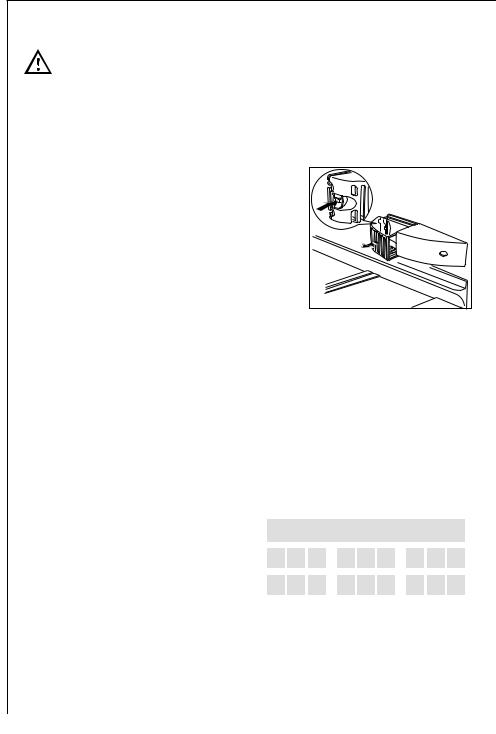
Changing the light bulb
Warning! There is a risk of electric shocks! Before changing the light bulb, switch off the appliance and unplug it, or disconnect from the mains supply.
Light bulb data: 220-240 V, max. 25 W
1. To switch off, press the ON/OFF button until the mains power light extinguishes.
2.Unplug the mains plug.
3.To change the light bulb, press on the
rear hook and at the same time slide the light bulb cover in the direction indicated by the arrow.
4. Change the faulty light bulb.
5.Refit the light bulb cover.
6.Put the refrigerator back into operation.
Customer Service
If you cannot find the remedy for a malfunction in these operating instructions, please contact your dealer or our customer service department. Addresses and telephone numbers are listed in the accompanying booklet "Guarantee Conditions/Customer Service Locations". Selective ordering of replacement parts can save unnecessary travel and costs. For this reason always provide the following appliance information:
• Model Name
• Model Number (PNC)
• Serial Number (S-No.)
This information can be found on the serial plate in the interior at the left of the appliance. We recommend that you enter this information here, so that it is handy if needed.
Note: The customer bears the costs of unjustified customer service calls even during the guarantee period.
24
